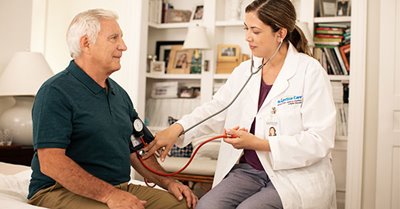 Blood pressure readings can be an important indicator of our health, particularly our heart health. But single, occasional measurements are just snapshots of our blood pressure at that moment. To truly manage our blood pressure, we have to look at the big picture.
Blood pressure readings can be an important indicator of our health, particularly our heart health. But single, occasional measurements are just snapshots of our blood pressure at that moment. To truly manage our blood pressure, we have to look at the big picture.
Many people only think about having their blood pressure checked when at the doctor’s office. However, up to 30 percent of people experience what is known as “white-coat hypertension,” or “white-coat syndrome.” This is when a person’s blood pressure readings are higher in the doctor’s office compared to at home. Doctor’s visits can be stressful, which can cause blood pressure to rise temporarily.
When the doctor has a more accurate picture of your loved one’s blood pressure day-to-day, they can make better care recommendations, such as adjusting medications or avoiding them all together.
How to check blood pressure at home
The American Heart Association recommends using an automatic, cuff-style, bicep (upper-arm) monitor. Once you’ve selected a blood pressure monitor, bring it to your loved one’s next doctor’s appointment. Your doctor can make sure both of you know how to use it and can get results that are as accurate as the doctor’s office equipment can provide.
There are many variables that can influence a blood pressure reading, so it’s important that it’s done properly. Here are a few tips to follow:
- Measure at the same time each day: Ask the doctor how often they would like your loved one’s blood pressure measured, such as once a day, or in the morning and evening. Try to do it during the same point of your loved one’s daily activity each time.
- Avoid measuring shortly after they smoke: Wait to measure blood pressure until at least 30 minutes after smoking.
- Help them relax: Rest 5 minutes before checking blood pressure. Unless the doctor requests blood pressure readings during or shortly after physical activity, it’s best to be as relaxed as possible.
- Ensure they sit correctly: If possible, have your loved one sit up straight with both legs on the floor. Their legs should not be crossed or curled up underneath them.
- Pull up shirt sleeves: It’s best to not take blood pressure measurements over clothes.
- Record the readings: This can be as simple as writing the information (time, date, measurement) in a notebook or in a spreadsheet. Your loved one’s doctor may give you a blood pressure log to record the measurements. There are also apps that you can use to log blood pressure readings.
Our BrightStar Care nurses take clients’ blood pressure at the beginning of care as part of a comprehensive health and wellness evaluation, and then they follow it regularly. They are happy to help you and your loved one properly monitor blood pressure at home and answer any questions.
Caregivers, don’t neglect your own heart health
Having chronically high blood pressure puts people at risk for stroke and cardiovascular events such as a heart attack. We also know that some forms of dementia can be influenced by cardiovascular health, including elevated blood pressure. The risk for high blood pressure increases as we age. Some health conditions, stress, and lifestyle habits such as lack of exercise also can increase the risk.
As a caregiver, it’s far too easy to put off your own health needs. High blood pressure often has no symptoms, so monitoring your own blood pressure can help you take control of your health while you care for your loved one.
When it comes to heart health, it’s important to look at the big picture. Keep an eye on your loved one’s blood pressure day-to-day to optimize overall health.
To learn how your loved one might benefit from our expert in-home care team, call 866-618-7827 or contact a BrightStar Care® home care agency near you.
